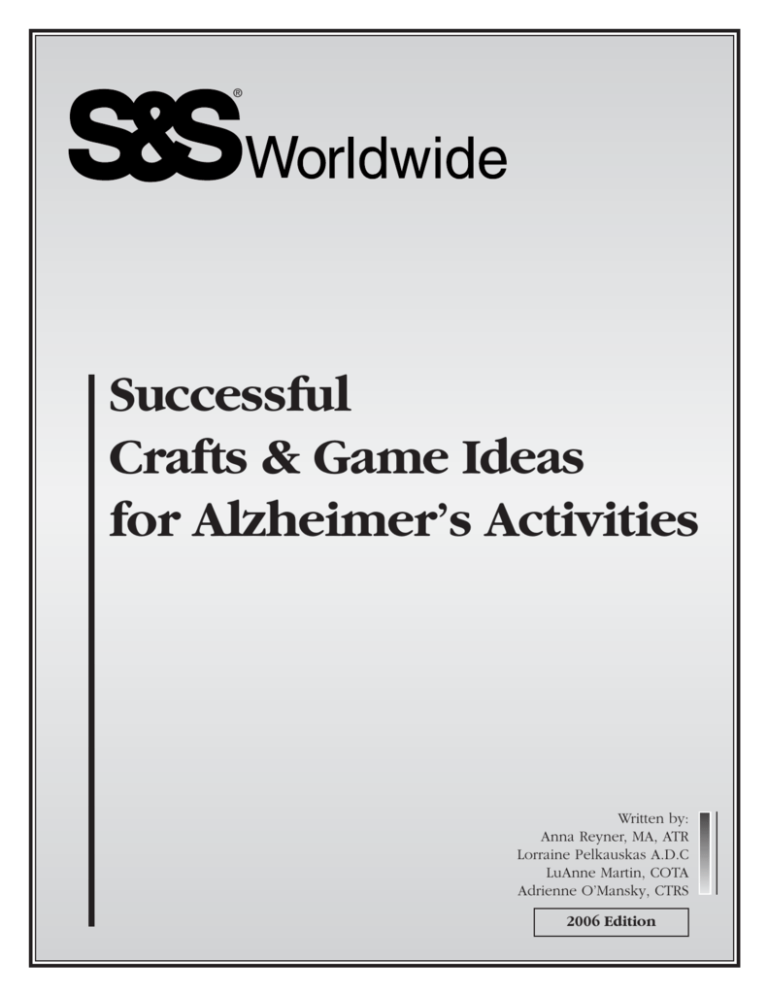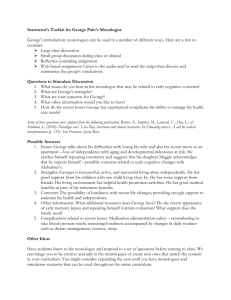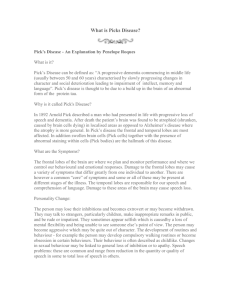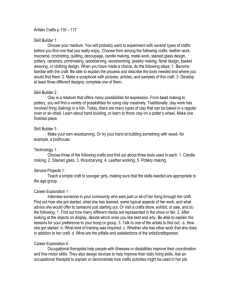
®
Successful
Crafts & Game Ideas
for Alzheimer’s Activities
Written by:
Anna Reyner, MA, ATR
Lorraine Pelkauskas A.D.C
LuAnne Martin, COTA
Adrienne O’Mansky, CTRS
2006 Edition
Successful Crafts and Game Ideas for Alzheimer’s Activities
Table of Contents
Page
Alzheimer’s Disease Fact Sheet ............................................................................3
How to Run a Successful Arts & Crafts Program ...................................................4
Let’s Have Fun with Therapeutic Activities .............................................................6
Why Arts & Crafts with Dementia Populations? .....................................................7
S&S® Group Packs: Activity Director Tested...........................................................7
Stocking and Using Basic Art Supplies ..................................................................8
Alzheimer’s Intervention Program Chart ................................................................9
Games for Fun, Sport and Exercise .....................................................................10
Successful Craft Ideas for People with Alzheimer’s .............................................10
Sensory Stimulation Cart ......................................................................................11
The item numbers listed throughout
this booklet can be found in the
2006 S&S® Primelife catalog.
If you do not have the catalog in which
an item appears, please call and request
a free copy.
1-800-243-9232
S&S Primelife®
© Copyright 2006 S&S® Worldwide, Inc. All rights reserved. Color Splash!® is licensed from Grandway USA.
2
Alzheimer’s Disease Fact Sheet
Statistics/Prevalence
• Half of all nursing home patients suffer
from Alzheimer’s or a related disorder.
The average cost per patient for nursing
home care is $42,000 per year, but can
exceed $70,000 per year in some areas
of the country.
• Alzheimer’s disease is a progressive,
degenerative disease of the brain and
the most common form of dementia.
• The average lifetime cost per patient is
estimated to be $200,000.
• According to the Alzheimer’s Association’s
analysis of national census data, Alzheimer’s
incidence in the U.S. will increase by
350% by mid-century, clustering in those
states with the highest numbers of
retired boomers. By 2025, experts predict,
820,000 elderly Californians and 712,000
Florida residents will be stricken with
Alzheimer’s disease.
• Alzheimer’s disease is the third most
expensive disease in the United States,
after heart disease and cancer.
• Currently, about 4.5 million Americans live
with Alzheimer’s. It is estimated that the
direct and indirect cost of their care will
total at least $100 billion annually.
• A person with Alzheimer’s lives an average
of 8 years and as many as 20 or more years
after the onset of symptoms.
Alzheimer’s Association of Orange County
2540-A North Santiago Blvd.,
Orange, California 92667 (714) 283-1111
Alzheimer’s Disease and Related Disorders Assoc., Inc.
www.alzoc.org
• U.S. society spends at least $100 billion
each year on Alzheimer’s disease. Neither
Medicare nor private health insurance
covers the type of long-term care most
patients need.
• More than 7 out of 10 people with
Alzheimer’s disease live at home. Family
and friends provide almost 75% of the
care required by patients in the home.
The remainder is “paid” care, costing an
average of $12,500 per year, most of which
is covered by families.
See Our Primelife®
Catalog for Senior
Recreational, Social and
Therapeutic Activities!
3
How to Run a Successful Arts & Crafts Program
for People with Alzheimer’s
By LuAnne Martin, COTA
Simplicity is the key to arts and crafts activity programming. Break down activities into simple
components.Then, accompany simple steps with:
• Reassurance • Encouragement • Praise • Respect
Important Goals for Your Program:
• To fill the day with positive experiences.
• To promote social interaction.
• To increase self-esteem.
• To normalize lifestyle.
• To minimize anxiety and mood swings.
• To focus attention on activities.
• To promote pleasure and enjoyment.
• To maximize functional performance.
• To provide safe, successful and stimulating activities.
• To maintain or promote coordination, strength and
range of motion.
To meet these important goals, remember these three things:
I. Planning:
II. Focusing:
III. Reassuring:
Plan projects that patients can do with success.
Focus on the response of the individual.
Reassure on a constant basis.
S&S® Worldwide:
100 years of
excellent service.
I. Planning: Plan arts and crafts projects that patients can do with success:
Plan and Order Supplies:
Order success-oriented crafts that are simple, but appropriate for adults.
Don’t select projects that are too difficult.
Look at the craft instruction sheet ahead of time.
Make up a sample craft, or have a volunteer make up a sample.
Keep samples on display and use them as a guide for the group.
Adapt and simplify any difficult steps; plan ahead for modifications.
Structure the Activity:
Have a definite opening to each arts and crafts session.
Work on a project for 15 minutes, then take a break before resuming.
Vary quiet and active activities; break with a quick exercise.
Never offer more than two choices.
Work at their cognitive level.
Demonstrate each step several times.
Make certain you’ve simplified all complex steps.
Reassure, encourage and praise.
Have a definite closing to each session.
To order: Call 1-800-243-9232
4
II. Focusing: Focus on the response of each individual, not the activity itself:
As simple or obvious as this may sound, after we’ve “done our homework” by carefully
selecting and ordering a craft project we think will be a good one, we sometimes have a
tendency to place too much focus on finishing the craft project successfully.This may lead us to
focus more on the project itself, rather than on each individual’s response to the activity.
Some tips on how to overcome this:
• Be a trained observer; be varied and flexible in your approach.
• Place your craft sample in the center of the group and discuss it.
• Describe each step of the project as it is performed.
• If patients won’t sit down, pace with them or talk with them.
• Provide social contact so they may begin to trust you more.
• If people are too restless to sit down to a task, change to something
more active and come back to crafts later.
• If someone gets up and leaves the group, they may simply not
understand the task being presented. Simplify and reassure.
III. Reassuring: Reassure on a constant basis:
• Offer a reassuring touch; place your hand on a knee; hold hands.
• Recognize each individual’s presence and participation.
• Let them know each one of them is special.
• Often they will stay in the group because they feel recognized
and affirmed.
• Laugh with them and show your own emotions and compassion.
Other Important Things To Know:
In moments of lucid thinking,Alzheimer’s patients are more aware of their loss than at other
times. In these moments old hobbies may prove frustrating.
Their moods, behavior and skill levels change constantly.An activity or approach that works
one time may not work the next. Be flexible.Try something different, or try later on.
Rushing a person will foster resistance and agitation. Be patient.
Distraction, rather than confrontation, proves more effective.
Do things or ask questions one at a time to avoid confusion.
When a person becomes agitated:
Respond calmly.
Remove him/her from the stimulus of others.
One-on-one interaction is usually imperative.
Use distraction and change the environment.
Walking and gross motor activities can be helpful.
Attempt to determine what precipitated the event.
Divert - Encourage - Divert - Praise - Divert - Reassure.
Find our Workstation Cabinet on page 158 in S&S Primelife®.
5
Let’s Have Fun
with Therapeutic Activities
By Lorraine Pelkauskas,A.D.C.
and Anna Reyner, MA,A.T.R.
See pages 12-2
9
in S&S Primelif ®
e for
Sensory Stimu
lation
Products
As recreation professionals, we know that everyone needs stimuli — recreational, social,
physical and intellectual. Participants with dementia disorders need this stimuli even more.
While the need for stimulation is still viable, people with dementia generally cannot recreate or
create by themselves.They require assistance.
We provide this assistance by picking activities that will arouse interest or motivate
participants to get involved.We also schedule activities to fit their needs.This can be
challenging, since the needs of people with dementia disorders vary so greatly.A good
recreation staff will be well prepared.
When is the best time for activity programming to happen? Periodically throughout the day,
as long as participants will tolerate activities.We all know that the stages of our
Alzheimer’s/dementia population vary.Therefore, depending on what stage each person is in,
group activity must be limited by size.To determine the size of the group, use this general
guideline:
Dementia Stage
Early Stages
Middle Stages
Late Stages
Group Participant Size
8-10 Participants Maximum
3-5 Participants Maximum
Usually 1:1 Participant:Staff
Number of Staff
2 or 3 Staff/Volunteers
1 or 2 Staff/Volunteers
1 Staff
Often, different stages are grouped together in a population, making it more challenging
to select crafts or games that everyone in the group can do. In many settings where activity
professionals work, the dementia population is grouped together with other frail elderly who
do not have any form of dementia.Whether people with dementia are grouped together or
integrated with other frail elderly populations, the recreation/activity professional must create a
group activity that benefits everyone.Achieve this by separating a project into tasks that each
person can accomplish and enjoy at their own cognitive level.
Nearly all craft activities involve multiple steps, some of which are easier than others.
The activity professional working with dementia populations with mixed ability levels can
benefit from breaking craft activities down into several steps.That way everyone is involved
and working cooperatively towards a common goal. Mid- or later-stage dementia participants
can find simple sorting tasks in almost any craft activity. For example, a tile trivet craft project
might involve four basic tasks: sorting the tiles, planning the design, gluing down the tiles and
mixing/pouring the grout.These steps can be “graded” by difficulty and assigned to different
people in the group, depending on their cognitive ability level.This almost guarantees
success, especially when the ratio of staff or volunteer involvement remains at the appropriate
range suggested above.
These same principles apply for people with dementia who are cared for in a variety of
settings. Recreation activities can and should happen anywhere a dementia/Alzheimer’s patient
is: at home or out for a visit, at senior centers, at adult day care centers and in nursing facilities.
Friendly, Fast Service! S&S® ships all in-stock items within 24 hours.
6
Why S&S Primelife® Arts & Crafts with Dementia Populations?
Arts and crafts provide a sense of purpose, socialization, non-competitive interaction,
tactile and visual stimulation and most importantly, a feeling of belonging. Craft kits are typically
easy-to-complete, success-oriented projects with most of the material preparation done for you,
allowing you to focus your energy on the group itself. Most programs will want to include both
craft group packs and basic art supplies in their arts and crafts programming. By combining
craft kits with basic art supplies, you can vary your program to include both structured projects
and open-ended creativity with no specific end product. It’s always good to offer variety, and it
is therapeutically appropriate to offer a range of structured and unstructured activities. Craft
kits are structured, but no two projects will look alike and there is plenty of room for
individuality in how clients decorate their projects.
Simple crafts have the advantage of being success-oriented and functional. Nearly all of the
crafts in the following list can be used for room decorations, gifts, jewelry, or to serve some
other practical purpose. Before beginning a craft group, try reminding people of the purpose
behind what they are making. Craft time should be perceived as purposeful activity, not a
pastime or (much worse) a waste of time! Remind people that their projects will hang in their
rooms, be a pillow to give to a grandchild, be a pin to wear at an upcoming holiday, etc. If you
can’t think of any purpose for a craft other than pleasure or social interaction, point out that
crafts help exercise their hearts, hands and minds, or that this craft project is provided to help
them relax or practice their concentration.Whatever your goal is, remind them that craft
projects are much more than busywork! If they see you have a goal in mind, they are more
likely to feel that the project has both purpose and dignity.
S&S Primelife® Group Packs: Activity Director Tested
S&S® Worldwide provides a wide range of products that are well-suited for work with
dementia populations.They have asked me to include some of my favorites in a listing here,
so that other activity professionals might benefit from the trial and error I went through in
discovering what works best.These specific products are ones that I have used time and
time again with tremendous success. S&S Primelife® has informative icons on completion
time for each product.They are products that have been created by S&S® Worldwide and are
available through their catalogs. See below for products shown in the S&S Primelife® Catalog.
1)
2)
3)
4)
Snuggle Zoo Gang™
Squish Art
Honeycomb Place Mat
Abstract Art Pack
Sewing and stuffing a cute small pillow.
Very easy, very creative.
Simple; if mistakes are made, try again.
Staff-assisted project 1:2 ratio. Creative!
HMH-ST2192
HMH-GP231
HMH-GP3
HMH-GP43
Visit our website for great specials! www.ssww.com
7
Page
354
166
177
179
Stocking and Using Basic Art Supplies
Having bulk supplies of arts and crafts materials is useful in many ways. Stock a range of materials
with different sensory stimulation properties. Many basic art materials are highly stimulating to sight
and touch, and some are stimulating to smell, as well. Use basic supplies for all levels or stages of
dementia. Later stages will find good sensory stimulation exercises in simple sorting projects with
pompons, beads, colored macaroni, etc. Sort these objects by either color or shape. Placing stickers
on colored paper can be constructive for middle and later stages. If the level and ability is a bit
higher, you can decorate a white cigar box with colored glue, colored rice and colored macaroni.
Sandpaper is always useful for men (and some women, too!) who associate only with former life
activity. Keep leftover pieces of wood on hand and let people sand as long as they like.When they
believe they are finished, ask if they would like to stain, paint or decorate their project. Of course,
remember to use non-toxic paints, as this population tends to put items in their mouth.
Have fun with glitter fabric paint. Usually the fabric used must be precut by staff or volunteers
in advance. Make an easy sample to follow, but allow imaginations to unfold.With open-ended
projects, it’s especially important to stress the “doing”or the process, not the finished product.
Construction paper may also be used in many different ways. Cut it into strips for each person
to decorate, then join them together into a paper chain or weave them into a mat.You can also
make a wonderful picture on construction paper using colored glue, chenille stems and sequins.
Beads and lacing make ever-popular open-ended activities, as long as you remember to order
beads with large holes and stiff lacing material that threads easily. Use heavy elastic cord ( BE404X –
HMH page 332) to make beading fun and easy. Some people might want to make necklaces or
bracelets to keep, while others might enjoy the act of stringing beads, but be just as happy to have
you “unstring”their project for use another day.Try beads on chenille stems and then make them
into rings to join together.
Get creative with your basics and compile a resource area in your activity room with magazines
and books with well-illustrated ideas for staff and volunteers to seek inspiration. Lots of open-ended
art projects evolve from the creativity of the staff as well as the creativity of the participants. Make
your activity area as inspirational as possible by creating colorful displays of finished arts and crafts
projects. If you are not creatively inspired, find a volunteer that loves arts or crafts and “delegate”
this important task. By recruiting volunteers and staff who truly value art activities, you enhance
the dignity of your program by illustrating that arts and crafts are meaningful and purposeful
activities for children, adults and older adults alike.
Basic Art Supplies - Available from S&S Worldwide
®
Poster Board
Construction Paper
Felt and Precut Felt
Glitter Fabric Paint
Crayola® Washable Paint
Craft Foam Sheets
Craft Foam Cutouts
Color Splash!® Non-Toxic Markers
Color Splash!® Liquid Tempera Paint
Stickers
Sequins
Craftsticks
Precut Paper Shapes
Wood Scraps
Sandpaper
Colored Macaroni
Papier Mâché
Colored Glue
Wiggly Eyes, all sizes
Pompons, all types
Chenille Stems
Beads - all types
Glue
Color Splash!® Watercolor
Color Splash!® Non-Toxic Paints
Color Splash!® Acrylic Paint
Color Splash!® Wood Stain
Order from our S&S Primelife® catalog.
Your complete
source for
Alzheimer’s
programming
8
Withdraws from social
situations, cries, decreased
appetite, unkempt, quiet.
Slumping in chair or sliding
out, excessive complaints,
increased displays of anger
or irritability.
Worried - refuses to leave
bedroom.Yelling and
arguing with others.
Depressed
Lethargic
Paranoid
Patient will participate in
relaxation activities and present
with calm affect.
Patient will participate in daily
activities with environmental
accommodations to decrease
complaints of fatigue.
Provide safe, calm environment with
familiar routine. Offer SensoryRec
activities to provide comfort.
Supportive positioning. Shorten visits or
daily activities. Schedule rest time.
Patient will engage in meaningful Individual contact, spiritual activities,
activity and present with brighter reminiscence programs and walking.
affect during and after activity.
Patient will engage in purposeful Ambulation or movement program.
exercise using adaptive
equipment/moderate prompts.
Pacing, restless, wandering,
continually crumbling
paper.
Fidgety
Speak in short phrases,utilize gestures,
pictures,communication board. Consult
with speech and language therapist.
Participate in familiar activities.
Patient will demonstrate
communication through gestures
and communication boards
with assistance.
30
Active Lap Tray HMH-13538
Portrait of a River/River Life
15
HMH-16431
Rhythm Band Instruments HMH-W6079 72
148
161
161
31
70
12-29
53
79
28
31
78
Page
Portable Desk HMH-10380
See enclosed “Successful Craft Ideas
for People with Alzheimer’s” and
“Games for Fun, Sport and Exercise
from S&S Primelife®”
Finger Fidget Exerciser Kit
HMH-11502
Finger Fidgets HMH-11503
Picture Set HMH-13409
or a quiet space. One phone call to family Backyard Bug Puzzle HMH-GA2432
or close friend. Nature activities.
Patient will participate in sensory Stimulate hands and feet. Improve
SensoryRec section of Primelife®
stimulation activities and increase positioning. Place recreation
participation in self care activities items within reach. Increase physical
Stirring Up Memories HMH-13408
(feeding, bathing and dressing).
activity. Meal preparation group.
Communication Mute, avoids eye contact,
Deficits
shakes head, difficult to
understand, does not
respond to staff.
Grimacing facial
expressions, refuses to
engage in daily activities,
remains in bed.
in 1-2 valued activities per day.
“get away from me.”
Motionless
Patient will participate in a
calming technique and participate
Oppositional to contact,
Yelling “help me”or
Anxious
Old Time Favorites Sing-A-Long
HMH-W2917
Tactile Dominoes HMH-10674
Activity Apron HMH-12486
Catalog Items–Primelife®
Soft music or environmental sounds, one- The Audio Pillow HMH-12469
to-one contact. Relocate patient in a study
Patient will participate with
Sensory arousing activities, food
accommodations in 1-3
preparation, place patient near activity
meaningful activities per day
locations, use headphones - tactile items.
with verbal and physical direction.
Repetitive picking, tapping
or rubbing. Destroying
clothing, holding stuffed
animals, repetitive noises,
self stimulation.
Bored
Treatment Interventions
Functional Goal
Area of Deficit Likely Observed Symptoms
$42.99
$39.99, 3 +.
$64.99
$36.99
$32.99, 6 +.
$57.99
$49.99, 3 +.
$19.99
$17.99, 3 +.
$14.99
$12.99, 3 +.
$52.99
$27.99
$24.99, 3 +.
$15.99
$44.99
$39.99, 3 +.
$18.99
$16.99, 6 +.
$19.88
$29.99
$24.99, 3 +.
Price
This easy-to-read chart offers clinicians a quick reference to deficits, symptoms, functional goals, treatment interventions and therapeutic
products to treat or maintain functioning of an Alzheimer’s patient.This table is not intended to be all-inclusive, but a general guide for
recreational, educational and occupational professionals to decrease time for documentation and suggest therapeutic activities.
Alzheimer’s Intervention Program
Games for Fun, Sport and Exercise Available from
S&S Primelife®
Therapeutic recreation takes many forms. Games offer a new challenge and offer participants
the sense of belonging. In general recreation, or in a non-therapy setting, games are usually
competitive and people concentrate on “winning.” However, people with dementia can do
exactly what they see with these same games (push the puck, throw the ball, etc.), but
approach them without care for the outcome.
Call today 1-800-243-9232 to receive a free copy of S&S Primelife®.
Product
Physical Requirement
Item Number
Page
Floor Basketball
Shuffleboard
Ring Toss
Bowl-A-Mania
Dutch Shuffleboard
Outburst® Bible Edition
Parachute & Accessories
Nok-Hockey®
Yahtzee®
Balls
Marshmallow Balls
Music that Always Works
“Sing Along with Eldersong” CD
“Old Time Favorites” Cassette
“Memory Lane” Cassette
“Patriotic Songs” Cassette
Throwing
Pushing
Throwing
Pushing
Pushing
You Never Know!
Lifting
Pushing
Just Shake the Dice!
HMH-GA2032
HMH-GA2038
HMH-HC69
HMH-W2197
HMH-W2142
HMH-W7507
HMH-W2367
HMH-W424
HMH-GA953
132
127
134
119
118
96
131
119
95
HMH-W4902
27
HMH-16331
HMH-W2917
HMH-AT3
HMH-W2921
78
78
80
80
Primelife®
Successful Craft Ideas for People with Alzheimer’s
From the 2006 S&S Primelife® (HMH) and
S&S® Recreation (RMG) Catalogs
Project Name
VERY EASY
My Garden Wall Panel*
3-D Tissue Pictures*
Squish Art*
Large Designer Panels
Designer Wall Panels
Tom Thumb Planters
Greeting Cards/Envelopes
Handled Letter Sponges
Item No.
Page No.
HMH-GP584
HMH-GP1201
HMH-GP231
HMH-GP41X
HMH-GP41
HMH-GP543
HMH-PE140
HMH-DC254
179
184
166
172
172
174
284
297
Occupational Therapists! Check out the Allen Diagnostic Module in
S&S Primelife®.
10
continued:
Product
Item #
MODERATELY EASY
Design-A-Hat*
RMG-GP482
Cloud Climbers*
RMG-GP619
Still Life and Landscapes
HMH-GP230
Super Foam™ Mosaic Doorknob Hangers* RMG-GP1505
African Mask Plaques
HMH-GP896
SLIGHTLY COMPLEX
Gold and Silver Foil Tooling Pack*
RMG-GP7
* Projects followed by an asterisk are appropriate group activities.
Page
46
82
168
39
189
50
Sensory Stimulation Cart
By Adrienne O’Mansky, MA, CTRS
LuAnne Martin, COTA
Claudia Allen, Cathy Earhart and Tina Blue have compiled a sensory motor stimulation kit,
creating an essential tool for professionals interacting with moderate to severe Alzheimer’s
patients. On page 27 of S&S Primelife® you will find two sensory motor kits for your
programming.These kits will include instructions to aid your programming.
After you receive your Sensory Motor Stimulation Kit you may want to utilize the following
suggestions by two geriatric healthcare professionals. Sensory stimulation is important for
people with Alzheimer’s, and you can assemble a Sensory Cart fairly easily and inexpensively.
Many of the items from the cart can be donated or purchased at garage sales; supplement
these basic materials with a few nice items from the S&S® Worldwide catalogs.
OBRA regulations require supportive activities for residents who are bedridden as well as those
who are ambulatory.The sensory cart provides stimulation for both of these groups, but fills a
special need for those residents who are unable to get out of bed.The sensory cart allows you
to visit residents at bedside and provide a wide range of stimulating materials, even for
residents with the most severe visual, motor or cognitive deficits.
A sensory cart consists of a wide range of stimulating materials.These include things you can:
• Taste
• Touch
• Smell
• Look At
• Share
How to Make the Cart Itself: You can make a simple cart by recycling an old cafeteria cart, as
long as its wheels still work. A simple, used cart can be embellished very creatively by you
or one of your volunteers. If your time is limited, fixing up a Sensory Cart makes a good
volunteer project. Not only is it very worthwhile, it’s also a lot of fun to make.
You can make your sensory cart bright and cheerful by painting it and adding various types
of felt, dried flowers, or whatever trims you have on hand. Use decorated and labeled shoe
boxes to store items on the cart. If necessary, secure the boxes to the cart by gluing them to
a shelf. Or, if budget permits, purchase plastic containers with lids.Another idea is to build three
sides on the cart to enclose it.The sides can be built up to make the cart more of a “cabinet” by
gluing corrugated paper to three of its four sides.You can even hang a curtain on the fourth
side to enclose the opening. Of course, you’ll keep the cart by your desk area or locked up
when not in use, so things will remain in their places.
11
Check out our SensoryRec
in S&S Primelife®
pages 12-29
What To Put On The Cart
This is just a starter list – pick and choose, then add your own ideas:
Magazines and simple books with pictures.
Old greeting cards with notes written inside.
Musical rhythm instruments.
Simple, quick crafts.
Dried flowers and scented potpourri.
Things that shine, glitter or glow in the dark.
Poems.
Grooming bags.
Simple puzzles.
Simple games.
Prisms, color wheels.
Religious music and readings.
Stereo cassette player.
Blank cassette tape.
Cassette tapes of various music and sounds.
Fabric swatches of different colors and textures.
Scratch and sniff stickers.
Lotions, preferably one with and one without
a scent.
How To Use The Cart
You can always use the cart as a group activity, but the biggest asset is the solution to the more
difficult problem:“What can I do to make my room visits more interesting for a bed-bound
resident?”Also,“How do I make room visits more interesting for me?”The sensory cart is really
a delightful way to make a room visit, and serves the supportive role of activity programming
encouraged by OBRA regulations. Since the sensory cart conforms with OBRA regulations, you
should have no trouble convincing your administration to provide you with the necessary
materials and budget to set one up.
Good luck! Have a good time making your cart.
Sensory Cart Ideas
From the 2006 S&S Primelife Catalog:
Description
Page
Price
Colored Collage Macaroni – HMH-TR13
Glitter Pompons – HMH-TR26
Fluff Feathers – HMH-BE1207
Quill Feathers – HMH-BE2865
Balloons – HMH-SL2379
Glow-in-the-Dark Beads – HMH-BE946
Rhythm Instruments – HMH-W6079 - W6080
343
344
347
347
108
334
72
$5.99 per 1-lb. bag.
$2.99 per pack of 80.
$1.99 per pack of 200.
$14.99 per pack of 144.
$8.59 per pack of 100.
$3.99 per 1/2-lb. bag.
$64.99 to $139.99 per set.
®
Recommended Adaptive Devices
Description
Page No.
Item No.
Dycem®
Snip Loop Scissors
147
304
HMH-24282
HMH-SZ275
Everything available in the 2006 S&S Primelife® Catalog.
12
HMH
NOTES
14
®
The
family of catalogs help people reach their greatest potential.
Please send me the following ______ catalogs:
S&S Primelife®
S&S® Recreation
Primelife® features a complete
line of products for Therapists
and Rehabilitation
Professionals. In addition to
our popular craft projects and
supplies, you’ll find a variety
of games, equipment and
accessories for occupational,
physical, sensory and
recreation therapy.
S&S® Education Plus!™
Our Education Plus!™
catalog is filled with highquality products, activities
and educational resources
for hands-on learning.
Our full-line S&S®
Recreation catalog
contains arts, crafts,
activities and all the
related supplies
needed to enhance
your program.
Sally® Party & Novelty
Your partner for fun
products! Sally® Party &
Novelty is filled with
unique prizes, toys,
gifts, party products
and novelty items.
For additional copies of this reprint, or copies of our catalogs:
Call Toll Free: 1-800-243-9232
Internet Home Page:
www.ssww.com
Fax 24 Hours A Day: 1-800-566-6678
E-mail Address:
service@ssww.com
Monday through Friday, 8 a.m. to 9 p.m., EST
Saturday 8 a.m. to 12 noon, EST.
To Order By Mail: S&S® Worldwide
P.O. Box 513
Colchester, CT 06415-0513
Request Item S-51 (2/06 )
Customer Service:
For questions or product information
Call toll free 1-800-937-3482
Monday through Friday,
8:00 a.m. to 7:00 p.m. EST.









